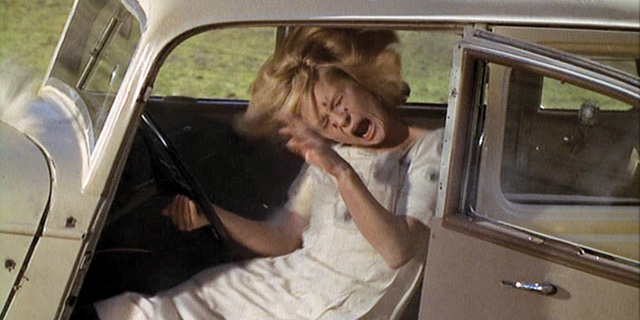Overview:
In this final scene, Bonnie and Clyde go shopping and enjoy a day out together before noticing a pair of cops and driving away. During said drive, they notice Malcom, C.W Moss’s dad, and stop to help him with what he claims is a flat tyre. After he leaps under his truck in fear, Bonnie and Clyde realise that this is a trap, and make for each other before being brutally shot down by a group of police with rifles hidden in the bushes beside the road. The cops investigate the two’s bodies, confirming that they are dead.
Key Elements:
Cinematography –
Unlike other scenes in this film, the final sequence is mostly done via stationary camera that smoothly glide to track the characters. The scene begins with Bonnie and Clyde centre frame to bring our attention to the, and the camera smoothly crabs left to follow their journey to the car. It tilts up to show Clyde and then tilts down to track his sitting into the car. He and Bonnie and kept in frame constantly to keep our attention on them here. She is even kept in frame from over his shoulder. Reaction shorts are also used as he drops his lens. Inside the car, he and Bonnie are shown close together to signal their emotional connection. When Clyde asks about getting ice cream, he points at the parlour, which is in frame but in the background as the focus is on them. A close up is used on Bonnie’s doll as she describes it, showing us what to pay attention to. Reaction shots are also used as Moss looks out the window at the events unfolding.
The camera gets tighter between the couple as the sequence goes on, showing how close they are to one another now. It is tightest on them as they eat the pear together, showing their emotional connection through physical proximity. Shot reverse shots are used as they drive up and speak to Malcom, such as him waving and them pulling over to talk to him. Despite this, the camera shakes inside the car as they pull up, and canted angles are used due to the camera being placed on a small slope to show the car pulling up. Reaction shots are used constantly towards the end of the scene, showing Malcom’s fear of being shot, and Bonnie and Clyde’s realisation that they are about to be killed. Through the finals shot of the couple lingering on their bodies, the film forces the audience to confront the tragedy of the situation and the brutality of the scene. The camera smoothly glides over to track the movements of the people walking up to the car, keeping our attention on them, the brutal scene that they have caused, and their reactions to it.
Sound –
The lack of non-diegetic composed music in this scene, including the typical blue gras music that accompanies the car scenes in this film, created tension and builds a sense of tragedy in the tone of the film.
Editing –
There are rapid shot reverse shots towards the end of the scene, building tension and showing the realisation of the characters of what is about to happen, signalling it to the audience. This rapid use of redaction shots is unlike normal continuity editing, edited instead almost as a montage. The use of slow motion forces the audience to confront the brutality of the killings for longer. They are not shot in the face though, as the film still wants to present it’s attractive, glamorous movie stars, who are made to appear as such throughout the film.
Mise-En-Scen –
Bonnie and Clyde wear bright clothing to bring our attention to them and present them as more innocent. The pear they eat serves as sexual imagery to represent how they are closer to each other now, and more trusting of each other, also implying that Clyde has gotten over his hesitance to move forward in his relationship with Bonnie. This makes their brutal end more tragic. The blood used to show gunshots make the final scene more brutal and shocking to the audience, forcing them to confront the violence and the consequences of the character’s actions.
Performance –
Despite their previous behaviours in the film, Bonnie and Clyde here are innocent, youthful and happy, Clyde acting clumsily and Bonnie giggling and fawning over him. This makes their deaths more sympathetic and tragic, eliciting an emotional response from the audience.
Context:
Representations and Aesthetics:
Despite their criminal career, brashness, smug attitudes and aggressiveness before this scene, Bonnie and Clyde are presented as more innocent characters here. Clyde makes the jokes, and Bonnie aughts gleefully at them. The cops are presented as the villains, the lead one wearing black, their faces grim and the group of them shown shattered glass, distancing the audience from them.
Auteur:

You must be logged in to post a comment.